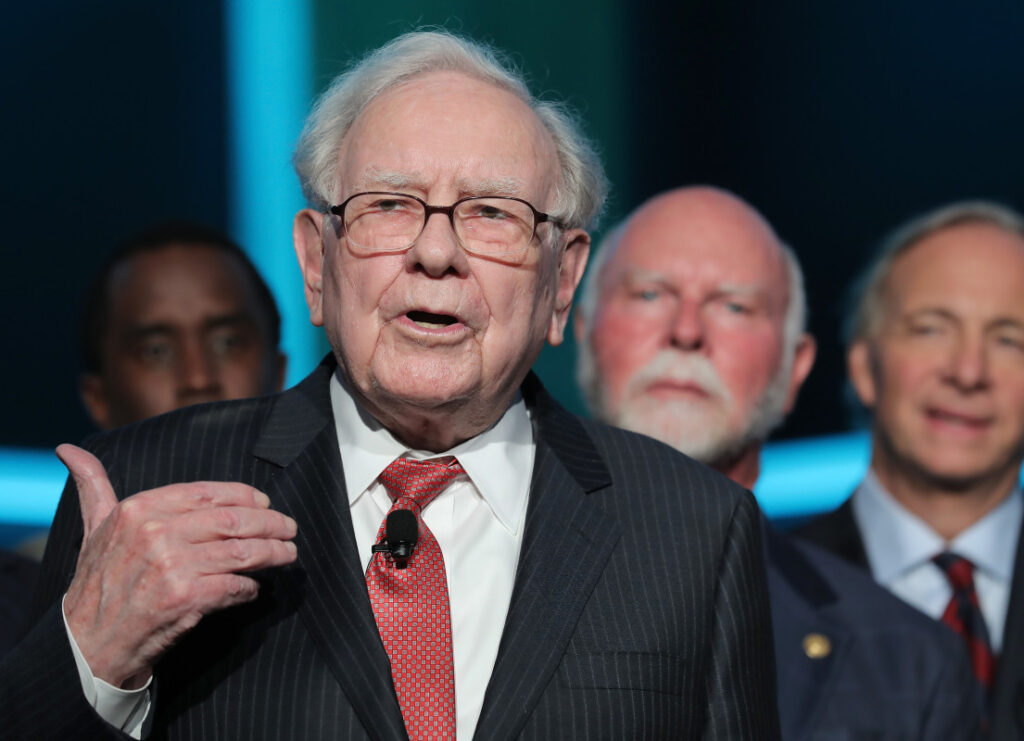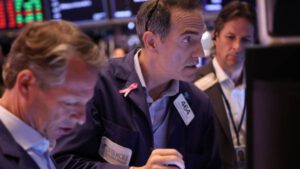Editor’s Note: Warren Buffett takes the long and slow approach to investing. Throughout his more than 80-year investment career, he tends to hold onto shares for the long term, but while he’s had his ups and down since he bought Berkshire Hathaway (BRK.A) , a fledgling textile company, in 1965, he has skillfully transformed it into a massive holding company that includes insurers, railroad operators, tech companies, and an assortment of small businesses.
As Buffett, 95, steps down as Berkshire’s CEO at the end of 2025, we highlight the five companies that produced Buffett’s biggest investment returns:
💵💰 Don’t miss the move: Subscribe to TheStreet’s free daily newsletter 💵💰
Image source: Countess/Getty Images
When Warren Buffett was just 11 years old, he made his first stock purchase, investing in three preferred shares of the Midwestern natural gas company Cities Service at roughly $38 per share.
According to biographer Alice Schroeder, the young Nebraskan spent a lot of time at the library and had just finished reading One Thousand Ways to Make $1,000, which introduced him to the concept of compound interest.
Needless to say, it left a big impression.
But the boy who would later become the “Oracle of Omaha” actually made a big mistake with his first investment, because he got scared and sold too soon.
The year was 1942: The U.S. had recently entered World War II, and Cities Service had a fleet of oil tankers that were being targeted by German U boats in the Atlantic’s cold waters.
The company had also begun to divest its 200 public utility assets, and, due to a federal court order, it was legally barred from paying dividends for several years.
By June 1942, preferred shares of Cities Service had plunged to just $27.
Buffett didn’t sell instantly; rather, he waited until the stock had regained its losses and was trading around $40 per share—selling it for a small $2 profit.
However, throughout the 1940s, while Cities Service was offloading its portfolio, its preferred shares were simultaneously accumulating a large number of unpaid dividends. By 1947, each share had accrued $84.50, and when the company was finally in a position to redeem the stock, the value of each preferred share was worth close to $200—an astounding sum, if only Buffett had held on.
Rest assured, the precocious investor learned quickly from his mistake. He went on to practice a more patient approach, studying at Columbia Business School under Benjamin Graham, the father of value investing, who would profoundly shape Buffett’s investment philosophy.
In fact, Buffett became famous for only buying quality businesses he believed in and then holding them for the long term. In his shareholder letter in Berkshire Hathaway’s 1988 annual report, he joked that his favorite holding period was “forever,” because when investors do the research and identify companies with high intrinsic value, their profits will compound over time.
Through Berkshire Hathaway, Buffett’s investments went on to net 5,502,284% over his decades-long career. Berkshire’s stock was just $19 when Buffett first bought the company in 1965, but by the end of September 2025, it was trading at an astounding $749,700. He wasn’t just good at identifying companies with long-term appreciation potential; he became one of the best at it, ever, and that’s why when Buffett speaks, the whole world listens.
View the original article to see embedded media.
What is Warren Buffett’s investing style?
A longstanding fixture on Forbes’ list of the planet’s 10 richest people, Warren Buffett has an estimated net worth of $148.9 billion as of September 2025. And even though he announced his impending retirement as CEO of Berkshire Hathaway at the end of 2025, Buffett still makes headlines for stock picking, most recently scooping up 5 million shares of United Healthcare (UNH) , the beleaguered insurance behemoth, in mid-August 2025. News of his purchase was taken as a green light for other investors, skyrocketing shares by 30%.
As a true value investor, Buffett has characterized his approach as seeking out the “cigar butt companies,” or ones trading significantly below their intrinsic value. He finds this by estimating a business’s free cash flow over a long-term period as well as applying a margin of safety. He also takes into account other metrics, like debt-to-equity ratios, earnings, and P/E ratios. By doing so, his holding company, Berkshire Hathaway, has minted enormous profits in names like GEICO and Coca-Cola (KO) .
In his later investment years, thanks to the insights of his BFF and right-hand man, Charlie Munger, Buffett’s style evolved to also include high-quality companies trading at fair prices: companies like See’s Candy and Apple (AAPL) .
Just how does Buffett identify the next “golden egg” for Berkshire Hathaway’s portfolio? He spends up to six hours a day reading up on business news and SEC documents, including annual reports and 10-K filings—often while enjoying a vanilla sundae with cherry syrup and nuts at his local Dairy Queen in Omaha, Nebraska.
Oh yeah; Buffett purchased that company, too, back in 1998 for $585 million.
In 2024 alone, Dairy Queen reported sales of $6.4 billion.
Related: How to read like Warren Buffett
What are Warren Buffett’s 5 biggest investing successes?
But even Dairy Queen’s ROI pales in comparison to some of Buffett’s other bets. Here are his five biggest.
Coca-Cola (KO): $816 million per year
After the 1987 stock market crash, Buffett began buying shares of the world’s leading soft drink manufacturer: Berkshire’s initial investment in the company was $1.3 billion. Coca-Cola had recently experienced some setbacks—including the infamous “New Coke” debacle—yet it still maintained a strong brand among consumers. It also had pricing power, growing global demand, and reliable cash flows.
Related: The 3 biggest mistakes Warren Buffett made as Berkshire CEO
In the years since, Berkshire’s investment in Coca-Cola has expanded many times over, thanks to both price appreciation as well as dividends. According to Yahoo Finance, Berkshire enjoys a staggering $816 million per year in dividends from this stock alone.
Apple (AAPL): $150+ billion
For a long time, Buffett considered tech stocks to be outside his area of expertise. He eventually came to see Apple as not only a tech leader but also a consumer brand with strong, consistent revenue growth and large free cash flows, as well as a company that rewarded its shareholders through dividends and buybacks.
Berkshire’s initial investment in Apple was $11.1 billion in 2016. By late 2024, when Berkshire began trimming its stake, its investment had grown to $163 billion. Despite the sale, Apple remains a major slice of Berkshire’s portfolio.
Related: This plush toy is making Warren Buffett even richer
American Express (AXP): $50+ billion
Buffett saw yet another opportunity in disguise with American Express (AXP) . In 1964, shares of American Express plummeted 50% due to an elaborate fraud from the Allied Crude Vegetable Oil & Refining Corp, which had secured massive loans for nonexistent soybeans.
Berkshire acquired a 5% stake in the company, estimated at around $20 million. In 1991, it added $300 million more. Thanks to the credit-card issuer’s strong brand and market dominance, Berkshire has become American Express’s largest shareholder, enjoying massive profits from price appreciation and dividends along the way.
Buffett’s famous friends:
- Bill Gates’ net worth: Just how much has he made — and given away?
- Melinda French Gates’ net worth: Life after her billion-dollar divorce
- Charlie Munger’s net worth: Everything to know about the late Berkshire Hathaway vice chair’s investments
GEICO: $40+ billion
Buffett has called insurance “the most important business at Berkshire,” because it profits from “float,” or the money held by insurance companies that has not yet been paid out to policy claims.
Buffett made his initial investment in GEICO in 1951. After the insurer nearly went bankrupt in the 1970s, Berkshire became a majority shareholder in 1976 before going on to purchase all remaining shares in 1996. The company remains a subsidiary of Berkshire Hathaway. However, its underwriting and distribution businesses as well as its ability to generate float are estimated by The Motley Fool to have generated more than $40 billion in returns for Berkshire.
Bank of America: $10+ billion
The global financial crisis of 2007-2008 produced another gem for Berkshire. The conglomerate’s stake began with a preferred stock investment in Bank of America (BAC) in 2011, when the bank was under distress.
Through the years, Buffett’s company has benefited both from capital appreciation and dividends. Even after selling 41% of its position in BAC in 2024 on fears of an increase in the corporate tax rate, Bank of America remains Berkshire’s third-largest holding.
Related: Warren Buffett’s net worth: A look at his fortune as he prepares to retire




